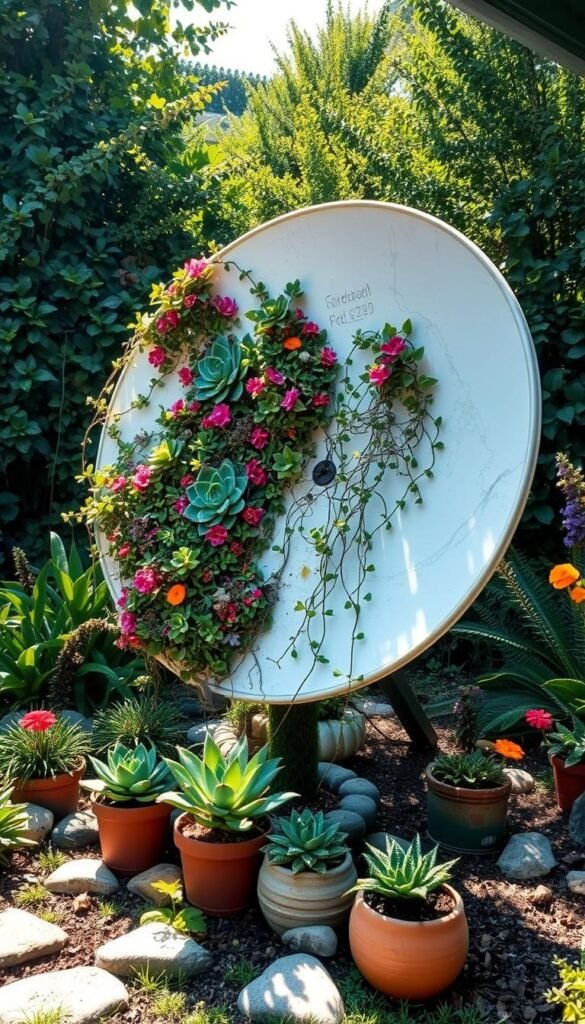Got an unused satellite dish gathering dust? Transform it into something extraordinary for your outdoor space. Repurposing these items combines creativity with eco-friendly practices, giving bulky equipment a fresh purpose while keeping harmful materials out of landfills.
Many don’t realize dishes contain lead or other toxins. By reimagining them, you protect the environment and craft unique decor. Imagine vibrant floral displays in curved metal or a striking sculpture that sparks conversations.
Eco-conscious homeowners are embracing this trend. It’s budget-friendly, sustainable, and lets you showcase personal style. Whether you’re a seasoned DIYer or new to creative projects, the possibilities are endless.
This guide covers everything from safety checks to design inspiration. You’ll learn to assess your dish’s condition, pick the perfect spot in your yard, and create features that blend function with artistry. Let’s build something beautiful—together.
Introduction: Revitalize Your Garden with Upcycled Satellite Dishes
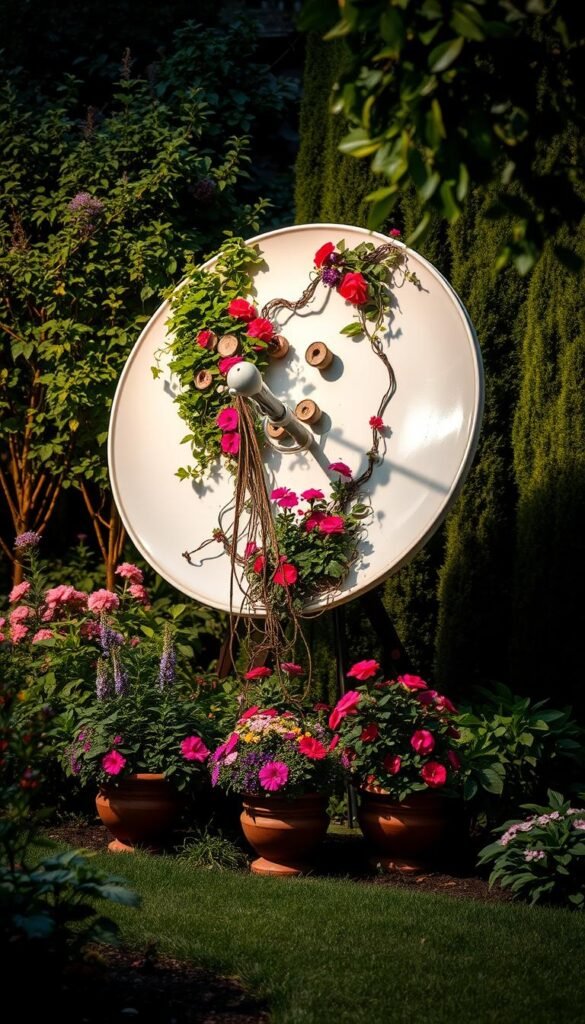
Breathe new life into unused objects with simple projects that combine practicality with artistic flair. Many homeowners overlook the potential of curved metal structures collecting dust in garages or backyards. These items become eco-friendly masterpieces through creative thinking.
What Is Upcycling and Why It Matters?
Unlike recycling, which breaks down materials, this process transforms forgotten items into higher-value creations. For example, durable parabolic shapes originally designed for TV signals become perfect bases for outdoor features. Their weatherproof construction means they’ll withstand rain, snow, and sun without rusting.
Benefits of Creating Unique Garden Decor
Custom pieces made from salvaged tech offer three key advantages:
| Feature | Store-Bought Decor | Repurposed Creations |
|---|---|---|
| Cost | $50-$300+ | $0-$20 (supplies) |
| Uniqueness | Mass-produced | One-of-a-kind |
| Eco-Impact | New resources used | Waste diverted |
Your projects keep electronic junk out of landfills while adding personality to your space. Friends will admire how you turned industrial leftovers into blooming displays or artistic focal points. Best part? You control the design – paint patterns, add mosaic tiles, or let climbing plants take over naturally.
Planning Your Upcycling Project: Preparing for Garden Art and Planters
Ready to transform that outdated tech into garden gold? Start by sizing up your equipment. Not all dishes are created equal—their size, shape, and condition will shape your design choices.
Assessing Your Equipment and Components
Begin with a thorough inspection. Look for rust spots, cracks, or warped edges that might affect stability. Metal dishes work best for outdoor use, while plastic versions may need weatherproofing. Check the mounting hardware—those sturdy brackets could become plant hangers or sculpture bases.
Don’t overlook smaller parts. The LNB (that little box on the arm) makes a quirky planter for succulents. Cables? Twist them into decorative edging or trellis supports. Every piece has potential.
Building Your DIY Toolkit
Gather essentials before starting. You’ll need basic tools like screwdrivers and pliers for disassembly. Safety gear matters—gloves protect against sharp edges, while goggles shield eyes during drilling. For mounting your creation, consider concrete mix or heavy-duty anchors.
Measure your garden space twice. A 3-foot dish needs different support than a 6-foot giant. Think about sunlight patterns and soil drainage where you’ll place your new garden feature. Sketch ideas that match your yard’s vibe—whimsical mosaics or sleek modern designs both shine.
Safely Removing and Repurposing Your Old Satellite Dish

Before getting creative, focus on safe removal practices. Whether your equipment sits on a roof or backyard pole, smart preparation prevents accidents. Start by contacting your satellite service provider—many offer free removal programs or recycling options for outdated hardware.
Safety Procedures and Local Regulations
Always check local e-waste rules first. Some areas require permits for removing large metal structures. If your dish sits high up, consider hiring professionals—a $150-$300 investment could prevent falls or property damage.
| Factor | DIY Approach | Professional Service |
|---|---|---|
| Cost | $0-$50 (tools) | $150-$300 |
| Safety Risk | High for roof units | Fully insured |
| Time Required | 4-6 hours | 1-2 hours |
| Equipment Handling | Your responsibility | Included in service |
Proper Disassembly for Recycling or DIY Improvements
Grab your toolkit: gloves, screwdrivers, and zip-lock bags for accessories. Label each part as you remove it—photos help during reassembly. Keep mounting brackets intact; they become sturdy bases for garden features.
Handle cables carefully. Cut power sources first, then coil wires neatly. Save every bolt—these small steps transform technical junk into artistic building blocks. With patience, that old satellite dish becomes tomorrow’s conversation-starting planter.
Step-by-Step Guide: Upcycling: Turn Old Satellite Dish Ideas into Garden Art and Planters
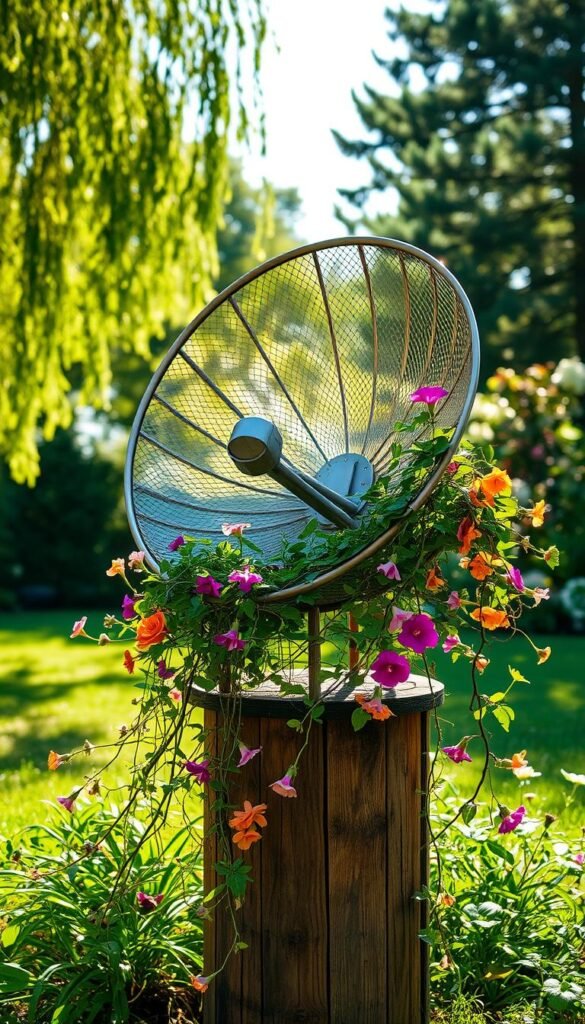
Unlock the hidden potential of your unused equipment with these hands-on methods. The curved structure that once captured signals now becomes a canvas for nature-inspired creativity.
Creating Unique Planters from Satellite Dishes
Start by drilling 5-7 drainage holes in the base using a 1/4-inch bit. Mix equal parts potting soil, perlite, and compost for optimal moisture control. Compact varieties like sedums or trailing lobelia work best for shallow depths.
Scrub the surface with vinegar solution to remove grime. Light sanding helps primer adhere—choose rust-resistant spray paint in your favorite hue. Let dry completely before filling with soil.
Transforming Dishes into Striking Outdoor Art
Turn the parabolic shape into a mosaic masterpiece using broken tiles or sea glass. Apply outdoor-grade adhesive in sections, pressing pieces firmly. Seal with clear marine varnish for weather protection.
For nighttime drama, wrap solar string lights around the rim. Secure with waterproof zip ties spaced 6 inches apart. Position near seating areas to create cozy ambiance after sunset.
Creative Garden Projects: Transforming Dishes into Bird Baths, Planters, and Art
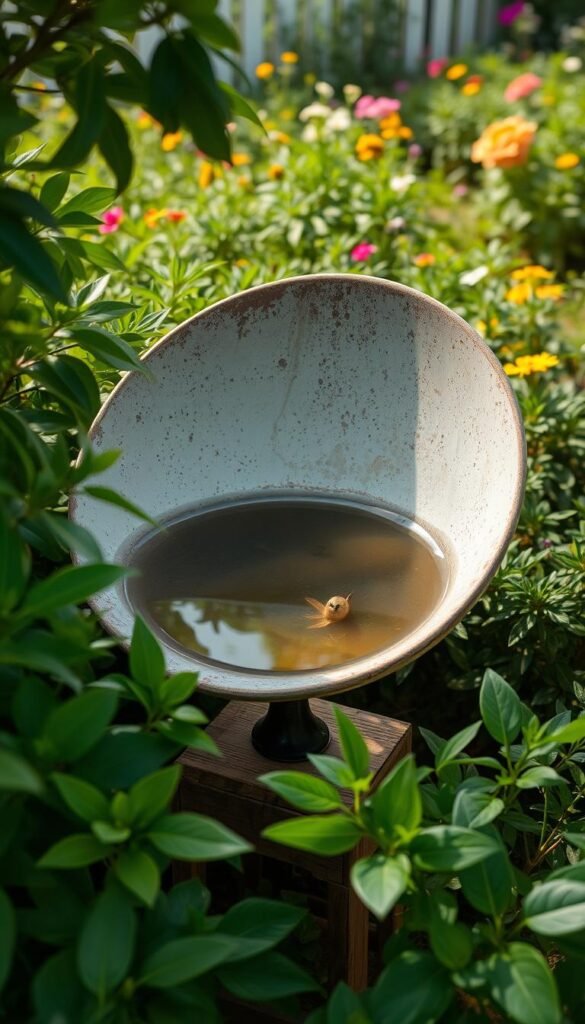
Ever imagined giving new purpose to forgotten tech? These curved structures shine when reimagined as eye-catching outdoor features. Let’s explore how everyday gardeners craft stunning displays that blend function with whimsy.
DIY Inspiration from Real Garden Projects
Brenda Tripp transformed her equipment into a moss-covered masterpiece. She spray-painted the surface cobalt blue, added a shimmering gazing ball, and planted golden moss around its edges. “It’s now the first thing visitors notice,” she says. Her project proves even basic supplies yield dramatic results.
For feathered friends, convert your find into a bird oasis. The natural bowl shape holds water perfectly. Add smooth stones for perching, and watch robins and sparrows splash happily. Position it near shrubs for quick shelter—birds appreciate safety while bathing.
Other inventive uses include:
- Herb planters with cascading thyme
- Mosaic sun catchers using broken china
- Wind-driven kinetic sculptures
Many creators pair their projects with yard sale finds like vintage lanterns or repurposed furniture. This approach builds cohesive designs while keeping costs low. Photos from community gardens show dishes painted like giant flowers or stacked as modern art installations.
Key to success? Match your creation’s scale to your space. A 4-foot piece makes a bold statement in small yards, while clusters of smaller dishes work as pathway accents. However you design it, your project keeps tech junk out of landfills while adding personality to your landscape.
Essential Tools, Tips, and Sustainability Practices for Eco-Friendly Upcycling
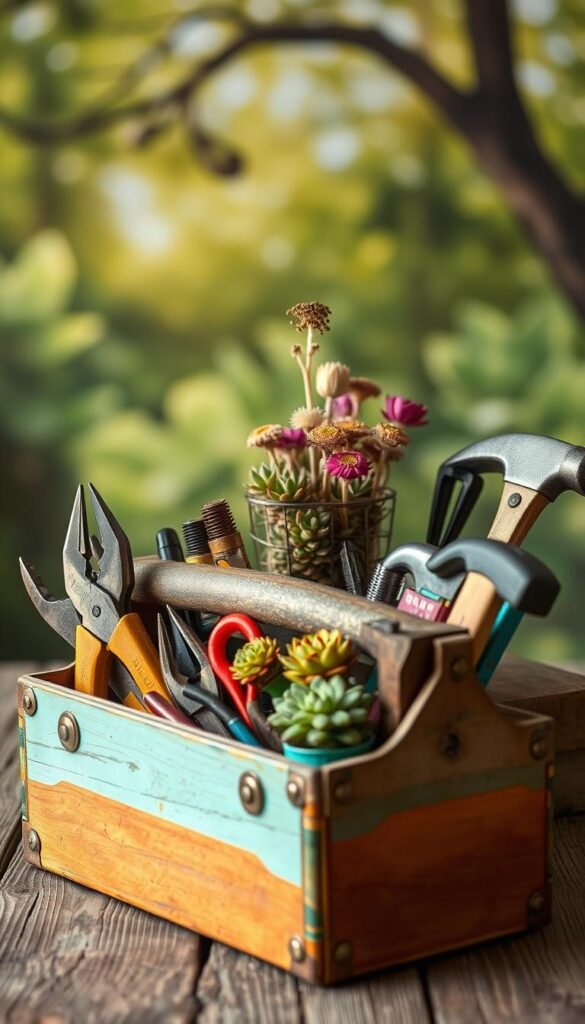
Transforming tech waste into garden treasures requires smart preparation. You’ll need basic tools like cordless drills for drainage holes and orbital sanders for surface prep. Safety goggles and work gloves protect you during disassembly, while a measuring tape ensures perfect placement in your yard.
Eco-Friendly Disposal and Recycling Methods
Not every component can become garden art. Separate materials like aluminum reflectors from plastic casings. Many communities host e-waste collection programs—some even pay for scrap metal. Check sites like Earth911.com for local drop-off points accepting satellite equipment.
| Disposal Method | Materials Accepted | Average Cost |
|---|---|---|
| Scrap Yards | Aluminum, Steel | $0.30-$1.50/lb |
| E-Waste Centers | Circuit Boards, Wires | Free-$10 fee |
| Retailer Programs | Full Systems | Free (store credit) |
Exploring Professional Services and Community Programs
Companies like EZ CleanUp handle tricky removals for about $200. “We’ve kept over 12,000 dishes from landfills since 2022,” shares their operations manager. Some cable providers offer free pickup when you upgrade your service.
Try these tips for zero-waste projects:
- Convert mounting brackets into trellis frames
- Use cable sheathing as plant ties
- Turn LNBs into miniature succulent pots
Always check local regulations before dismantling large systems. With the right approach, you’ll give every bolt and wire new purpose today.
Inspiring Real-Life Upcycle Projects and Garden Transformations
Imagine stepping into a garden where curved metal forms bloom with trailing petunias and sunlit mosaics glitter under open skies. Across the U.S., creative minds are redefining outdoor spaces using unexpected materials, proving that innovation thrives where technology meets nature.
Featured Garden Experiences and Innovative Ideas
In Oregon, a retired teacher transformed her backyard using three repurposed dishes. One became a shaded gazebo draped in clematis vines, while others now serve as tiered herb planters. “They create natural conversation starters,” she notes. Her design blends cottage charm with industrial elements, proving that contrasting styles can harmonize beautifully.
Seasonal changes keep these projects dynamic. A Michigan family swaps summer geraniums for frost-resistant kale in their elevated planter. Pairing these features with rustic charm items like weathered benches creates cohesive themes. Vertical gardening solutions shine here—one urban grower attached eight small dishes to a fence, each hosting strawberries or nasturtiums.
Key lessons from successful creators:
- Use lightweight soil mixes to prevent structural stress
- Paint interiors white to reflect heat from summer sun
- Group odd-numbered clusters for visual balance
Whether crafting a floral centerpiece or a shaded retreat, your area gains personality while keeping tech waste out of landfills. As plants mature and cascade over edges, these installations evolve into living sculptures that captivate year-round.
Final Reflections on Your Garden Upcycling Journey
Your journey with repurposed tech doesn’t end here—it’s just the beginning. By transforming unused equipment into functional decor, you’ve joined a growing movement of gardeners blending sustainability with style. Every bolt repurposed and wire reused keeps harmful materials out of landfills while adding character to your outdoor space.
Whether crafting planters or artistic installations, remember: small changes create big impacts. Pair these projects with budget-friendly container gardening methods to maximize both savings and creativity. Your garden becomes a testament to resourcefulness, where salvaged items bloom alongside thriving plants.
Keep experimenting with shapes and textures. Metal curves catch raindrops like nature’s own sculptures, while painted surfaces reflect sunlight in playful patterns. Share photos of your creations to inspire others—your ingenuity might spark the next wave of eco-conscious ideas.
Now step outside and admire how discarded items have found new purpose. That’s the magic of giving junk a second life: it grows more beautiful with time.

